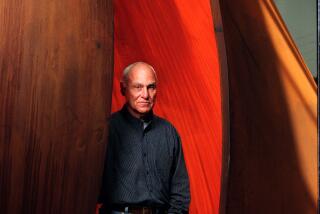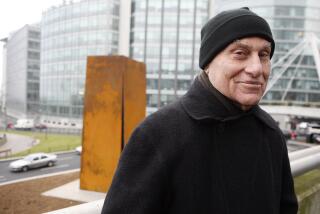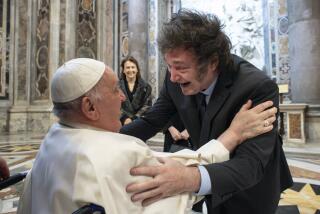Father Junipero Serra to be elevated to sainthood, Pope Francis says

- Share via
Catching most of the Catholic faithful by surprise, Pope Francis announced Thursday that he plans to canonize Father Junipero Serra, the 18th-century Spanish Franciscan priest both revered and reviled for founding nine missions in California.
“He was the evangelizer of the West in the United States,” said the pontiff, whose statement came as an aside while he was flying to the Philippines on the final leg of his Asian tour. In comments carried by Catholic News Service, Francis said he would bypass the usual requirement that a second miracle be verified to bestow sainthood.
The decision to elevate Serra as an exemplar of piety and faith was met with joy, shock, pain and condemnation — a reflection of the complicated and polarizing legacy left behind in California that persists even centuries after Serra’s 1784 death at the Carmel mission near Monterey. The mission system cemented Catholicism in the state but nearly eradicated several Indian tribes.
“He was a very assertive and aggressive missionary,” said Steven Hackel, a professor of history at UC Riverside and the author of a biography on Serra. “What he symbolizes in the Catholic Church is their attempt to teach Indians to live as Spanish Catholics rather than who they were born as.”
Archbishop Jose Gomez, head of the archdiocese of Los Angeles, called Serra one of his “spiritual heroes.”
“It’s wonderful to think that this new saint once walked the road that is now the Hollywood Freeway and called it El Camino Real, ‘The King’s Highway,’” Gomez said in a statement, noting that two of Serra’s missions are located within the archdiocese’s territory: missions San Gabriel Arcangel and San Buenaventura.
Serra was born on the Spanish island of Mallorca on Nov. 24, 1713, and volunteered for New World mission work at age 36 after obtaining a doctorate in theology and developing a career in religious academia in Spain, according to a biography on the Santa Barbara Province of the Franciscans’ website.
He was first assigned to the remote Sierra Gorda region in what is now south-central Mexico’s Queretaro state. He worked among indigenous Pame Indians, then embarked on an itinerant preaching mission across Mexico.
In 1758, he was dispatched to head a group of other Spanish Franciscans in evangelizing the inhabitants of Baja and Alta California, as the current U.S. state was then known.
He settled 11 years later in San Diego, where he spent most of his remaining years.
Before Serra’s arrival, hundreds of thousands of indigenous people had lived in what is today California.
But the mission system imposed pressure on Indians to assimilate while also exposing thousands to foreign diseases, wiping out villages, native animals and plants.
“Most Indians who came to missions didn’t live very long,” Hackel said. “Those baptized lived short lives.
“It was an oppressive system for most Indians: Indians were told to pray a certain way, act a certain way, dress a certain way,” Hackel said. “Once baptized, native peoples could not leave the compound without permission.”
To some Indians, that history has made missions difficult, even haunting places to visit today, but to those tribes whose land was lost altogether, ending any opportunity for a federally recognized reservation, missions are one of the few links to history.
“There’s no resolution as to why things had to happen the way they did,” said Carrie Lopez, a member of the San Luis Rey Band of Mission Indians in Oceanside who is also a practicing Catholic. Explaining that she has “very mixed feelings” about Serra, Lopez said, “It will always be sad the toll that it took on our ancestors. That won’t ever change.”
Serra is not without his champions, who hail his dedication and courage. Franciscan Father John Vaughn of the Santa Barbara mission was one of Serra’s key advocates for canonization, and Gomez called the pope’s decision a “gift to California and the Americas.”
Also Thursday, Francis said he intended to seek sainthood for Joseph Vaz, a Portuguese missionary to Sri Lanka who predated Serra by a couple of decades.
The pontiff’s announcement about Serra stoked speculation that he might add a visit to California to his scheduled trip this fall to the United States.
The pontiff is scheduled to visit Philadelphia in September to attend a world gathering of Catholic families. He is expected to also make stops at the United Nations in New York and in Washington to meet President Obama.
No details of canonization ceremonies have been disclosed.
Twitter: @cjwilliamslat
Twitter: @MattHjourno
More to Read
Sign up for Essential California
The most important California stories and recommendations in your inbox every morning.
You may occasionally receive promotional content from the Los Angeles Times.












